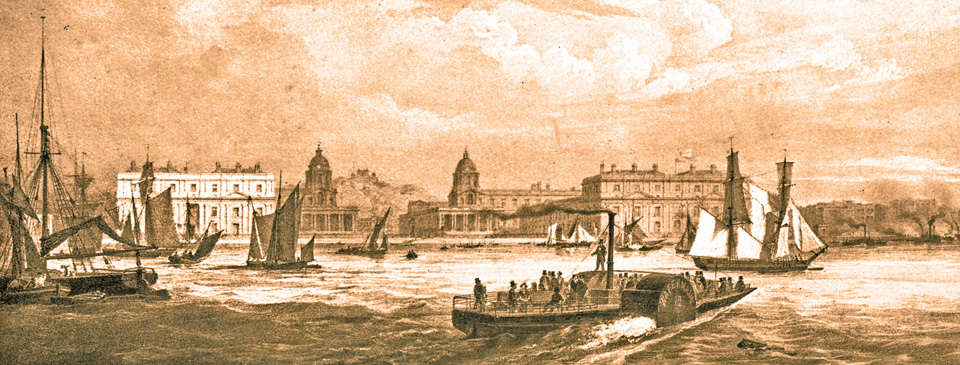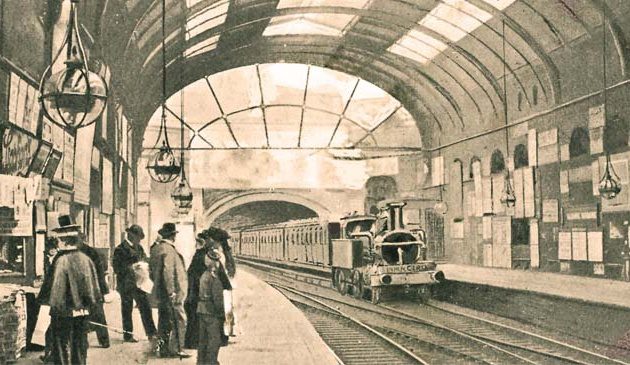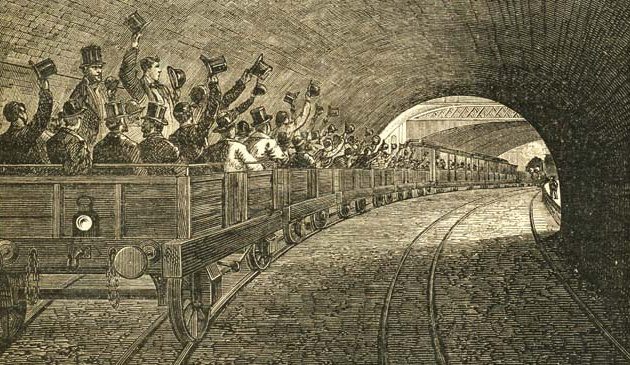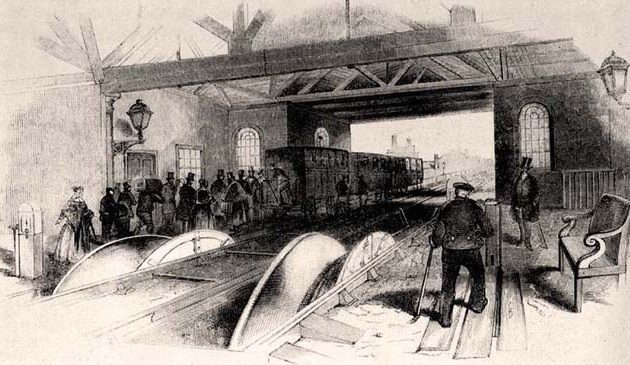Victorian passenger steamboats on the Thames

A vessel of the Waterman Steamboat Company in the 1840s. Other steamboats can be seen in the distance on the right of the picture. It appears not to have any below-deck cabins and was therefore probably a ‘short-ferry’, plying between Greenwich and London rather than a long-ferry or designed for longer day-trips. The Waterman’s pier at Greenwich was constructed to take a million passengers a year.
The introduction of steamboat services on the River Thames in the early 19th century made it possible to commute to London from as far as Gravesend. They also gave ordinary Londoners their first opportunity to take day or weekend trips to Estuary and coastal resorts such as Southend, Margate, and Ramsgate.
The earliest steam-powered boats were developed in France during the 18th century, then later in Scotland and New York. The engine on these early steamboats powered paddle-wheels on each side of the vessel. By 1819 steamship design had advanced enough that vessels were capable of crossing the Atlantic. The first sea-crossing by an iron-hulled steamship was in 1822.
Such was the poor state of England’s roads in the early 19th century that it was far easier to make the journey from the north-east of England to London by sailing vessel, typically taking about nine days. By the 1840s coastal steamships had cut the longer journey from Edinburgh to London to just three days.
For a 30-year period, between 1830 and 1860, the Thames was busy with paddle-wheeled steamboats of various sizes, zig-zagging between the many piers on either side of the river, smoke belching from their tall, jagged-edged funnels. Rings around their funnels indicated their destination. On weekdays they were used by business commuters, and for pleasure trips at weekends. It was estimated that 200 steamers were working on the river by 1844. The weekly Steamboat Excursion Guide was being published in London by 1841.
The earliest of the steamboats were built along the lines of sailboats but with the addition of a steam engine, a funnel, and paddle wheels. The hulls were of very similar design. Below deck, larger vessels were built with a fore-cabin forward and a saloon cabin aft of the engine room. Both were entered by means of a steep flight of stairs. Many steamboats were designed double-ended to allow them to swiftly zig-zag across the river from pier to pier. One of the leading companies building paddle-steamers was Yarrow’s on the east side of the Isle of Dogs.
There were numerous piers along the river through London from which to catch a boat, especially prior to the construction of the Victoria Embankment. In 1837 there were steamboat services operating between Kew, Richmond, Chelsea, Westminster Bridge, Hungerford Market, London Bridge, Blackwall, Woolwich, and Gravesend. ‘Short-ferries’ operated to and from London and Greenwich and Woolwich. Prices on short journeys were very low due to cut-throat competition, with London Bridge to Westminster costing 1d (one penny) and London Bridge to Chelsea just 2d (two pence). During the early 1840s as many as 17 scheduled steamer ‘long-ferry’ departures left daily in each direction from London to Gravesend. In 1846 there was a steamer leaving London Bridge for Westminster by rival companies every four minutes for the 15-minute journey.
For passengers alighting from Blackwall Railway trains there were also steamers from Brunswick Pier at Blackwall to Gravesend, a journey of about one hour. Most passengers arriving at Gravesend disembarked at Town Pier but those vessels belonging to the Blackwall Railway Company berthed at Terrace Pier. Steamboats moored at Gravesend departed by 7am and thus provided a means for residents of the town to commute into their place of work in the City.
Steamboat services gave many working-class families their first opportunity to take an excursion out of London by water to Kew, Richmond and Hampton Court. It was a means of escape from the overcrowded and smoky streets of the capital to the green countryside of Surrey, Kent and Essex or to former fishing villages that had been transformed into pleasure resorts.
In summer months services took passengers on day or weekend trips along the Thames Estuary to Sheerness, Herne Bay, Southend, Margate, and as far as Ramsgate on the Kent coast. In 1932 the three Margate Steam-Boat Company’s steamers carried 100,000 passengers from St. Katharine’s Dock. The General Steam Navigation Company were already operating from London to Margate, Ramsgate, and Yarmouth prior to 1837 and continued well into the 20th century with only a break for the First World War. Such trips were a leisurely and pleasant affair, with a three-piece band on board, including a harpist, and starting the day with breakfast for one shilling. In some weeks steamers left London for Herne Bay and Margate on alternate days, returning the following day. In the height of the season they sailed daily, returning the same day. Ramsgate was reached by the powerful vessels of the Commercial Company, leaving London Bridge Wharf and calling at South Woolwich. In 1845 the fastest steamer on the Thames was the Herne, which could travel from Blackwall to Herne Bay in three hours and forty-nine minutes. Larger, long-distance boats could carry over a thousand passengers on the river but their licences only permitted half those numbers on the Estuary and open sea beyond Sheerness. Some middle-class families spent entire summers at one of the resorts. The husbands continued working in the City, taking the first steamer – the ‘husbands’ boat’ – out of London on Saturday morning to join the wife and children.
A popular weekend destination for Londoners was Rosherville pleasure gardens, which opened at Northfleet in 1837, reaching a peak twenty years later when 20,000 people visited in one week. The gardens were laid out over seventeen acres in disused chalk pits. Two brass bands greeted visitors, who were able to visit a zoo, a Gothic dining room, and a theatre, and be entertained by famous performers.
Southend-on-Sea in Essex is not actually on the sea but is located where the Thames Estuary opens out enough that the Kent coast on the far side is only just visible. The transformation from a few fishing huts into a major resort at the south end of the original village of Prittlewell began in the late 18th century, with the Grand Hotel opening in 1794. The water is very shallow and the sea recedes a long distance at low tide, making it difficult for boats to reach the shore. In 1829 the Lord Mayor of London, Sir William Heygate, was a resident of the town and he resolved to have a pier built out into the Estuary that would allow passengers to board and disembark from boats, even a low tide. A 600 feet-long wooden pier was opened the following year, complete with a horse-drawn railway. Thereafter excursion steamers could bring holiday-makers from London during the summer months.
When steamers originally began arriving at Herne Bay it was necessary for passengers to reach the shore by means of a hoy, that is a small sailing boat. As the number of visitors increased, George Burge, who had been contracted by Thomas Telford to construct the St. Katharine Docks, led a group of investors in constructing a pier, specifically for steamers. It was designed and built by Telford’s assistant, Thomas Rhodes, while Telford himself was constructing nearby Whitstable Harbour. The 3,000 feet-long pier opened in 1832, at the same time as the Pier Hotel. The steamer service was discontinued in 1862, under competition from the railway, and the original pier dismantled in 1870.
Margate was a simple fishing village until sailing vessels began bringing holiday-makers in the 18th century, lured by the town’s fine sand beaches. Others came for the healthy sea air. In 1815 the engineer John Rennie completed the harbour, allowing steamships to bring large numbers of Londoners to the town. One of those who arrived by steamer in 1829 was the artist J.M.W Turner, and thereafter he often stayed at Margate, fascinated by its sunsets.


